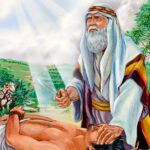The Book of Esther stands as one of the most captivating and dramatic narratives in the Old Testament. Set within the Persian Empire, it tells the story of a young Jewish woman who rises to become queen and, through faith and courage, saves her people from destruction. While the book is unique in that it never explicitly mentions God, His providence and unseen hand are woven throughout the story. This fascinating book teaches profound lessons about divine sovereignty, moral courage, faith, and identity.
BACKGROUND AND HISTORICAL CONTEXT OF THE BOOK OF ESTHER
The Book of Esther is set during the reign of King Xerxes I (Ahasuerus), who ruled the Persian Empire from 486–465 B.C. The events take place in the royal city of Susa (Shushan), where many Jews were still living after the Babylonian exile. Although some Jews had returned to Jerusalem under Zerubbabel and later Ezra, many remained in Persia, integrating into the empire’s political and social systems.
Understanding the Book of 1 Chronicles: Genealogy and Kingdom
The Persian Empire at this time was vast, stretching from India to Ethiopia. The Jews, being a minority, often faced discrimination and vulnerability. Against this backdrop, Esther’s story unfolds—a tale of a Jewish orphan who becomes queen and an unlikely heroine in a time of danger.
This historical context is crucial because it reflects the tension between living faithfully in a foreign land and navigating survival in a society with different values and gods.
SUMMARY OF THE BOOK OF ESTHER
The narrative of Esther unfolds like a divine drama filled with suspense, irony, and redemption.
- Chapters 1–2: King Xerxes holds a lavish banquet and deposes Queen Vashti for disobedience. A beauty contest is then held to find a new queen, and Esther, a young Jewish woman raised by her cousin Mordecai, is chosen for her beauty and grace.
- Chapters 3–4: Haman, a high-ranking official, becomes enraged when Mordecai refuses to bow to him. In his anger, Haman plots to annihilate all the Jews in the empire. Mordecai urges Esther to use her position to intercede for her people, warning her, “Who knows but that you have come to your royal position for such a time as this?” (Esther 4:14, NIV).
- Chapters 5–7: Esther courageously approaches the king, risking her life, and invites him and Haman to two banquets. During the second banquet, she reveals her Jewish identity and exposes Haman’s plot. The king, enraged, orders Haman to be hanged on the very gallows he had built for Mordecai.
- Chapters 8–10: The king grants the Jews the right to defend themselves. The Jews triumph over their enemies, and the festival of Purim is established to commemorate their deliverance.
Understanding the Book of 1 Kings: Wisdom and Idolatry
The story concludes with Mordecai’s promotion and the establishment of Purim as a lasting reminder of God’s hidden hand in saving His people.
THE THEME OF PROVIDENCE: GOD’S INVISIBLE HAND
One of the most remarkable features of the Book of Esther is that God’s name is never mentioned. Yet, His presence permeates every scene, decision, and coincidence. This intentional omission highlights a profound theological truth: even when God seems absent, He is always at work behind the scenes.
a. Divine Orchestration of Events
From Esther’s selection as queen to the sleepless night of the king that leads to Mordecai’s honor (Esther 6:1–3), every event unfolds as part of a divine plan. What appears to be chance is actually divine providence—God working invisibly through human actions and decisions.
Understanding the Book of 1 Samuel: Kingship and Transition
For example:
- Esther’s beauty and favor before the king were not mere luck.
- Mordecai’s uncovering of the assassination plot positioned him for later recognition.
- Haman’s pride led to his own downfall in poetic justice.
These “coincidences” reveal a master plan woven by the invisible hand of God to preserve His covenant people.
b. Providence in the Absence of Miracles
Unlike Exodus or Daniel, Esther contains no miracles, visions, or direct revelations. This silence underscores a different kind of divine activity—subtle, providential care that operates through ordinary events. It reflects how God often works in the background of our lives, arranging circumstances for His glory and our good (Romans 8:28).
THE THEME OF COURAGE: STANDING FIRM IN FAITH
The second major theme in Esther is courage—the kind that arises from faith, love, and conviction. Esther’s bravery is not the absence of fear but the triumph of faith over fear.
Understanding the Book of 2 Kings: Judgment and Exile
a. Esther’s Transformation
When first introduced, Esther is obedient and cautious. She conceals her Jewish identity as Mordecai instructs. But when Haman’s decree threatens her people, she undergoes a profound transformation. Her response—“If I perish, I perish” (Esther 4:16)—marks the moment she accepts her divine calling.
Her courage inspires believers today to rise above comfort and fear to fulfill their God-given purpose. Courage in Esther’s story is a moral choice made in alignment with faith rather than self-preservation.
b. Mordecai’s Steadfast Faith
Mordecai’s courage is equally significant. He refuses to bow before Haman, even under threat of death. His declaration of loyalty to God’s people reflects a deep conviction in divine sovereignty. Through Mordecai, we learn that faithfulness to God may attract opposition, but it ultimately leads to victory.
Understanding the Book of 2 Samuel: Kingdom and Sin
c. The Ripple Effect of Courage
Esther’s courage not only saved her people but also transformed the Persian court and inspired generations of believers. Her story shows that one person’s courage can ignite collective deliverance. True leadership often begins with a single act of faith.
LESSONS FROM THE BOOK OF ESTHER
The Book of Esther continues to speak timeless truths to readers today. Here are key lessons we can draw from its pages:
a. God Works Even When He Seems Silent
Life often feels like God is distant or inactive, but Esther’s story reminds us that His silence does not mean His absence. Even when we cannot trace His hand, we can trust His heart.
Understanding the Book of 2 Chronicles: Kings and Reforms
b. Courage Comes from Purpose
Esther’s courage was rooted in understanding her purpose. Likewise, when believers understand their divine calling, they can act boldly even in uncertainty. As 2 Timothy 1:7 says, “For God has not given us a spirit of fear, but of power and of love and of a sound mind.”
c. Divine Timing Is Perfect
Esther’s elevation and the king’s sleepless night both happened at the perfect moment. God’s timing is never late; He orchestrates events according to His divine calendar.
d. Evil Schemes Cannot Overcome God’s Plans
Haman’s plot backfired because God’s plan for His people is unshakable. Psalm 37:12–13 reminds us, “The wicked plot against the righteous… but the Lord laughs at the wicked, for he knows their day is coming.”
e. Deliverance Leads to Celebration
The festival of Purim is a symbol of joy after trial. It celebrates how mourning turned into gladness (Esther 9:22). Likewise, God transforms our tests into testimonies and our pain into praise.
Understanding the Book of Ezra: Restoration and Rebuilding
THEOLOGICAL INSIGHTS AND MODERN APPLICATIONS
a. The Sovereignty of God in Secular Settings
Esther’s story occurs entirely within a secular, political environment, showing that God’s sovereignty extends beyond sacred spaces. He rules over kings and kingdoms, guiding history toward His redemptive purposes.
b. Women in God’s Redemptive Plan
Esther’s prominence underscores the importance of women in God’s mission. Like Deborah, Ruth, and Mary, she played a vital role in preserving God’s covenant people. Her story affirms that God uses both men and women to accomplish His divine will.
c. Courage as a Spiritual Discipline
Esther’s courage was not impulsive—it was preceded by fasting, prayer, and discernment. Spiritual courage grows through communion with God. When faced with moral challenges, believers are called to seek divine wisdom before acting.
Understanding the Book of Nehemiah: Leadership and Rebuilding
RELEVANCE OF THE BOOK OF ESTHER TODAY
In an age where faith is often marginalized, Esther’s story reminds believers that God’s people can thrive even in hostile environments. It teaches how to live faithfully, wisely, and courageously in societies that may not share biblical values.
- In leadership: Esther exemplifies integrity, humility, and moral strength.
- In adversity: She models perseverance under pressure.
- In faith: She embodies trust in God’s unseen providence.
Just as God positioned Esther in the Persian palace, He places each of us “for such a time as this” (Esther 4:14)—to bring light, justice, and truth into our world.
CONCLUSION: PROVIDENCE AND COURAGE FOR ALL GENERATIONS
The Book of Esther is not merely a historical account—it is a divine masterpiece revealing how God’s providence and human courage intersect to fulfill His purposes. Though God’s name is absent from its pages, His presence fills every line. Esther’s courage changed history, proving that faith and boldness can overcome the gravest of threats.
Understanding The Book Of Job: Suffering And Sovereignty
Her story inspires us to live courageously and trust in the providence of a God who is always working, even when we cannot see Him. Whether in times of crisis or calm, God calls His people to stand firm, act faithfully, and remember that His hidden hand always leads to redemption.
Understanding The Old Testament: Genesis to Malachi
Last modified: November 10, 2025

